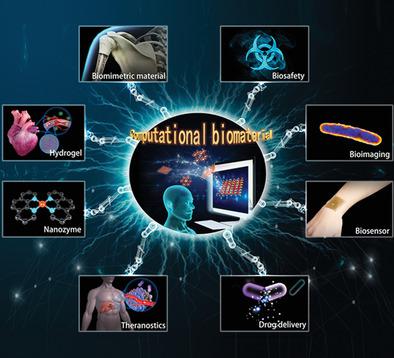当前位置:
X-MOL 学术
›
Adv. Mater.
›
论文详情
Our official English website, www.x-mol.net, welcomes your
feedback! (Note: you will need to create a separate account there.)
Computational Biomaterials: Computational Simulations for Biomedicine
Advanced Materials ( IF 27.4 ) Pub Date : 2022-08-02 , DOI: 10.1002/adma.202204798 Xinyue Dai 1 , Yu Chen 1, 2
Advanced Materials ( IF 27.4 ) Pub Date : 2022-08-02 , DOI: 10.1002/adma.202204798 Xinyue Dai 1 , Yu Chen 1, 2
Affiliation

|
With the flourishing development of material simulation methods (quantum chemistry methods, molecular dynamics, Monte Carlo, phase field, etc.), extensive adoption of computing technologies (high-throughput, artificial intelligence, machine learning, etc.), and the invention of high-performance computing equipment, computational simulation tools have sparked the fundamental mechanism-level explorations to predict the diverse physicochemical properties and biological effects of biomaterials and investigate their enormous application potential for disease prevention, diagnostics, and therapeutics. Herein, the term “computational biomaterials” is proposed and the computational methods currently used to explore the inherent properties of biomaterials, such as optical, magnetic, electronic, and acoustic properties, and the elucidation of corresponding biological behaviors/effects in the biomedical field are summarized/discussed. The theoretical calculation of the physiochemical properties/biological performance of biomaterials applied in disease diagnosis, drug delivery, disease therapeutics, and specific paradigms such as biomimetic biomaterials is discussed. Additionally, the biosafety evaluation applications of theoretical simulations of biomaterials are presented. Finally, the challenges and future prospects of such computational simulations for biomaterials development are clarified. It is anticipated that these simulations would offer various methodologies for facilitating the development and future clinical translations/utilization of versatile biomaterials.
中文翻译:

计算生物材料:生物医学的计算模拟
随着材料模拟方法(量子化学方法、分子动力学、蒙特卡罗、相场等)的蓬勃发展,计算技术(高通量、人工智能、机器学习等)的广泛应用,以及高性能计算设备、计算模拟工具引发了基础机制层面的探索,以预测生物材料的多种物理化学性质和生物学效应,并研究其在疾病预防、诊断和治疗方面的巨大应用潜力。在此,提出了“计算生物材料”这一术语,以及目前用于探索生物材料固有特性的计算方法,例如光学、磁学、电子和声学特性,并总结/讨论了生物医学领域相应生物学行为/效应的阐明。讨论了应用于疾病诊断、药物输送、疾病治疗和特定范例(如仿生生物材料)的生物材料的理化特性/生物性能的理论计算。此外,还介绍了生物材料理论模拟的生物安全评估应用。最后,阐明了此类生物材料开发计算模拟的挑战和未来前景。预计这些模拟将提供各种方法来促进多功能生物材料的开发和未来的临床转化/利用。讨论了应用于疾病诊断、药物输送、疾病治疗和特定范例(如仿生生物材料)的生物材料的理化特性/生物性能的理论计算。此外,还介绍了生物材料理论模拟的生物安全评估应用。最后,阐明了此类生物材料开发计算模拟的挑战和未来前景。预计这些模拟将提供各种方法来促进多功能生物材料的开发和未来的临床转化/利用。讨论了应用于疾病诊断、药物输送、疾病治疗和特定范例(如仿生生物材料)的生物材料的理化特性/生物性能的理论计算。此外,还介绍了生物材料理论模拟的生物安全评估应用。最后,阐明了此类生物材料开发计算模拟的挑战和未来前景。预计这些模拟将提供各种方法来促进多功能生物材料的开发和未来的临床转化/利用。并讨论了特定的范例,例如仿生生物材料。此外,还介绍了生物材料理论模拟的生物安全评估应用。最后,阐明了此类生物材料开发计算模拟的挑战和未来前景。预计这些模拟将提供各种方法来促进多功能生物材料的开发和未来的临床转化/利用。并讨论了特定的范例,例如仿生生物材料。此外,还介绍了生物材料理论模拟的生物安全评估应用。最后,阐明了此类生物材料开发计算模拟的挑战和未来前景。预计这些模拟将提供各种方法来促进多功能生物材料的开发和未来的临床转化/利用。
更新日期:2022-08-02
中文翻译:

计算生物材料:生物医学的计算模拟
随着材料模拟方法(量子化学方法、分子动力学、蒙特卡罗、相场等)的蓬勃发展,计算技术(高通量、人工智能、机器学习等)的广泛应用,以及高性能计算设备、计算模拟工具引发了基础机制层面的探索,以预测生物材料的多种物理化学性质和生物学效应,并研究其在疾病预防、诊断和治疗方面的巨大应用潜力。在此,提出了“计算生物材料”这一术语,以及目前用于探索生物材料固有特性的计算方法,例如光学、磁学、电子和声学特性,并总结/讨论了生物医学领域相应生物学行为/效应的阐明。讨论了应用于疾病诊断、药物输送、疾病治疗和特定范例(如仿生生物材料)的生物材料的理化特性/生物性能的理论计算。此外,还介绍了生物材料理论模拟的生物安全评估应用。最后,阐明了此类生物材料开发计算模拟的挑战和未来前景。预计这些模拟将提供各种方法来促进多功能生物材料的开发和未来的临床转化/利用。讨论了应用于疾病诊断、药物输送、疾病治疗和特定范例(如仿生生物材料)的生物材料的理化特性/生物性能的理论计算。此外,还介绍了生物材料理论模拟的生物安全评估应用。最后,阐明了此类生物材料开发计算模拟的挑战和未来前景。预计这些模拟将提供各种方法来促进多功能生物材料的开发和未来的临床转化/利用。讨论了应用于疾病诊断、药物输送、疾病治疗和特定范例(如仿生生物材料)的生物材料的理化特性/生物性能的理论计算。此外,还介绍了生物材料理论模拟的生物安全评估应用。最后,阐明了此类生物材料开发计算模拟的挑战和未来前景。预计这些模拟将提供各种方法来促进多功能生物材料的开发和未来的临床转化/利用。并讨论了特定的范例,例如仿生生物材料。此外,还介绍了生物材料理论模拟的生物安全评估应用。最后,阐明了此类生物材料开发计算模拟的挑战和未来前景。预计这些模拟将提供各种方法来促进多功能生物材料的开发和未来的临床转化/利用。并讨论了特定的范例,例如仿生生物材料。此外,还介绍了生物材料理论模拟的生物安全评估应用。最后,阐明了此类生物材料开发计算模拟的挑战和未来前景。预计这些模拟将提供各种方法来促进多功能生物材料的开发和未来的临床转化/利用。











































 京公网安备 11010802027423号
京公网安备 11010802027423号